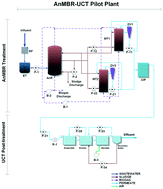当前位置:
X-MOL 学术
›
Environ. Sci.: Water Res. Technol.
›
论文详情
Our official English website, www.x-mol.net, welcomes your
feedback! (Note: you will need to create a separate account there.)
Fate of endocrine disruptor compounds in an anaerobic membrane bioreactor (AnMBR) coupled to an activated sludge reactor†
Environmental Science: Water Research & Technology ( IF 3.5 ) Pub Date : 2017-11-29 00:00:00 , DOI: 10.1039/c7ew00382j M. R. Abargues 1, 2, 3, 4, 5 , J. Ferrer 1, 5, 6, 7, 8 , A. Bouzas 1, 2, 3, 4, 5 , A. Seco 1, 2, 3, 4, 5
Environmental Science: Water Research & Technology ( IF 3.5 ) Pub Date : 2017-11-29 00:00:00 , DOI: 10.1039/c7ew00382j M. R. Abargues 1, 2, 3, 4, 5 , J. Ferrer 1, 5, 6, 7, 8 , A. Bouzas 1, 2, 3, 4, 5 , A. Seco 1, 2, 3, 4, 5
Affiliation

|
The occurrence and fate of three groups of micropollutants – alkylphenols, pentachlorophenol and hormones – were studied in a pilot plant consisting of an anaerobic membrane bioreactor (AnMBR) coupled to an activated sludge reactor (University of Cape Town configuration – UCT). Under anaerobic conditions, the octylphenol and technical-nonylphenol soluble concentrations increased producing negative degradation ratios (i.e., −175 and −118%, respectively). However, high 4-n-nonylphenol and bisphenol-A degradation ratios (92 and 59% for 4-n-nonylphenol and bisphenol-A, respectively) as well as complete pentachlorophenol, estrone, 17β-estradiol and 17α-ethinylestradiol removal were observed. Under aerobic conditions (UCT), octylphenol, technical-nonylphenol, 4-n-nonylphenol and bisphenol-A degradation ratios were higher than 84%. The AnMBR thus removes a high proportion of 4-n-nonylphenol, pentachlorophenol, estrone, 17β-estradiol and 17α-ethinylestradiol, but requires a later post-treatment process (such as UCT) to improve bisphenol-A, octylphenol and technical-nonylphenol degradation ratios. The overall AnMBR–UCT degradation ratios were 48% and 70% for octylphenol and technical-nonylphenol, respectively, and higher than 97% for 4-n-nonylphenol and bisphenol-A. The AnMBR produced a higher micropollutant accumulation in the sludge than the UCT: removal by adsorption in the AnMBR process was between 0.5 and 10%, and less than 0.5% in the UCT process. The combination of AnMBR and UCT technologies produces an effluent stream with low concentrations of micropollutants.
中文翻译:

厌氧膜生物反应器(AnMBR)与活性污泥反应器耦合的内分泌干扰物化合物的命运†
在由厌氧膜生物反应器(AnMBR)和活性污泥反应器(开普敦大学配置– UCT)组成的中试工厂中研究了三类微量污染物的发生和结局:烷基酚,五氯苯酚和激素。在厌氧条件下,将辛基苯酚和技术壬基苯酚可溶性浓度增加产生负降解率(即,-175和-118分别%)。但是,观察到较高的4-正壬基苯酚和双酚A降解率(4-正壬基苯酚和双酚A分别为92%和59%)以及五氯苯酚,雌酮,17β-雌二醇和17α-炔雌醇的完全去除率。在好氧条件下(UCT),辛基苯酚,工业壬基苯酚,4-正壬基苯酚和双酚A的降解率高于84%。因此,AnMBR去除了高比例的4-正壬基苯酚,五氯苯酚,雌酮,17β-雌二醇和17α-炔雌醇,但是需要后期的后处理工艺(例如UCT)来改善双酚A,辛基苯酚和工业级壬基苯酚。降解率。辛基苯酚和工业壬基苯酚的总AnMBR–UCT降解率分别为48%和70%,而对于4- n则高于97%-壬基酚和双酚-A。与UCT相比,AnMBR在污泥中产生了更高的微污染物累积:在AnMBR工艺中,吸附去除率在0.5%至10%之间,而在UCT工艺中,小于0.5%。AnMBR和UCT技术的结合产生了具有低浓度微污染物的废水。
更新日期:2017-11-29
中文翻译:

厌氧膜生物反应器(AnMBR)与活性污泥反应器耦合的内分泌干扰物化合物的命运†
在由厌氧膜生物反应器(AnMBR)和活性污泥反应器(开普敦大学配置– UCT)组成的中试工厂中研究了三类微量污染物的发生和结局:烷基酚,五氯苯酚和激素。在厌氧条件下,将辛基苯酚和技术壬基苯酚可溶性浓度增加产生负降解率(即,-175和-118分别%)。但是,观察到较高的4-正壬基苯酚和双酚A降解率(4-正壬基苯酚和双酚A分别为92%和59%)以及五氯苯酚,雌酮,17β-雌二醇和17α-炔雌醇的完全去除率。在好氧条件下(UCT),辛基苯酚,工业壬基苯酚,4-正壬基苯酚和双酚A的降解率高于84%。因此,AnMBR去除了高比例的4-正壬基苯酚,五氯苯酚,雌酮,17β-雌二醇和17α-炔雌醇,但是需要后期的后处理工艺(例如UCT)来改善双酚A,辛基苯酚和工业级壬基苯酚。降解率。辛基苯酚和工业壬基苯酚的总AnMBR–UCT降解率分别为48%和70%,而对于4- n则高于97%-壬基酚和双酚-A。与UCT相比,AnMBR在污泥中产生了更高的微污染物累积:在AnMBR工艺中,吸附去除率在0.5%至10%之间,而在UCT工艺中,小于0.5%。AnMBR和UCT技术的结合产生了具有低浓度微污染物的废水。










































 京公网安备 11010802027423号
京公网安备 11010802027423号